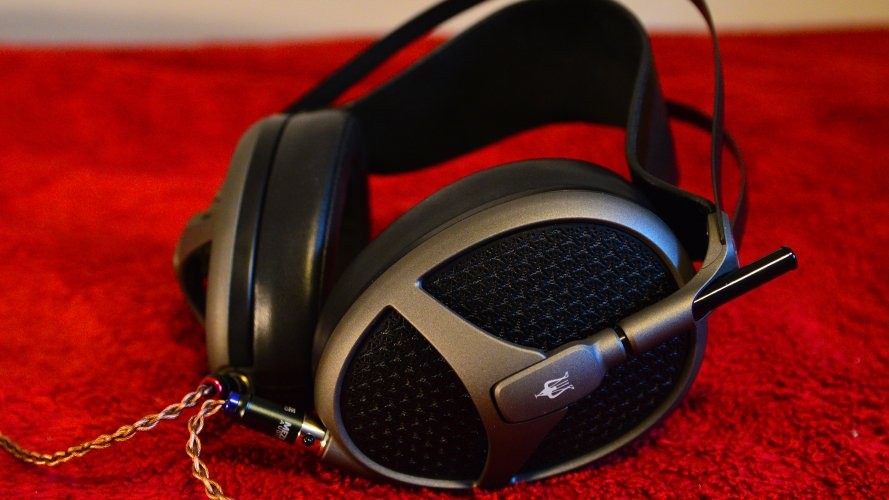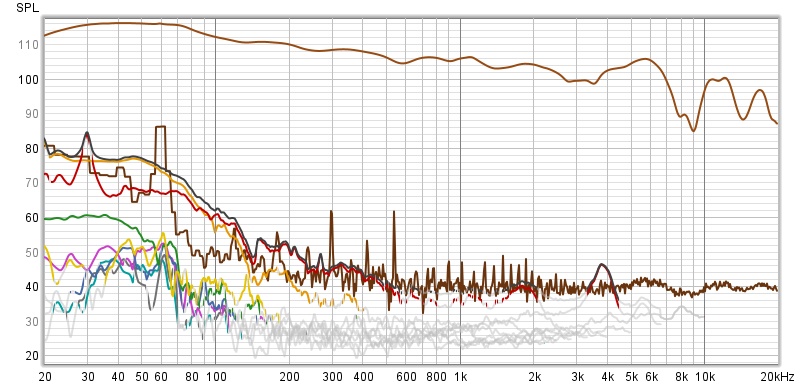So I recently acquired some in-ear microphones from
Earfish (datasheet can be found at
https://www.farnell.com/datasheets/1653468.pdf):

I suspect that these ones don't fit as deeply as the ones used with the Smyth Realiser A16 or in some academic canal entrance HRTF measurements, but these do the job. Their wires need to be supported by the included headband to prevent their position being disturbed between measurements, else they will be all over the place. These measurements inherently exclude the ear canal resonance which in my case considering the area that I EQed down, and such showing up in my measurements, resides around 3 kHz.
Frequency response measurements (magnitude and phase):
Here we have the canal entrance magnitude and phase response for the Meze Elite for my ears; only the left channel is shown since the right microphone has sub-bass roll-off. Again, this excludes the canal resonance which as you can see in
https://www.audiosciencereview.com/forum/index.php?threads/ear-resonance-gain-chart-confusion.26426/ would for 45 degree incidence incur a peak around 2.5 kHz to 3 kHz and a rise in the surrounding frequencies consistent with HRTF ear gain.
Looking at page 8 of
https://www.phon.ucl.ac.uk/courses/spsci/AUDL4007/12.pdf, that canal gain peak is present, whereby as we approach a 90 degree incidence, the 6 kHz concha resonance becomes more prominent. Of course, the close to 90 degree incidence provided by headphones isn't exactly free-field and has the influence of resonances and nulls within the earpad enclosure.
Meze Elite hybrid pads - 98 dBA unsealed playback:
Here, a distinct peak can be seen at 6 kHz
at least for my ears which can be very audible in spectrally dense music and singled out with sine sweeps and pink noise. The excessive levels here contribute to my hearing the constant hiss of overly amplified noise within many recordings. Hence, at the minimum, I strongly recommend EQ to clean up peaks you might have never realized were veiling your listening experience and keeping you away from exquisite clarity.
Meze Elite angled Alcantara pads - 98 dBA unsealed playback:
This graph was normalized with the previous about 1 kHz. The bass to midrange bloat is seen to be brought down by an impressive 4 dB consistent with my headphones.com Harman based EQ, likewise slightly linearizing the area above 1 kHz. This does improve clarity, but at the cost of sub-bass extension, and without addressing the 6 kHz resonance (which here has moved to 5.7 kHz perhaps because the drivers are now a bit further from the ears). The top octave response is fairly similar, and likewise at a similar level relative to 1 kHz and the 6 kHz peak. These pads could still be perceived as brighter if one finds themselves raising the volume levels to bring the bass and midrange forward toward their original levels. There are not much phase response differences of interest.
Meze Elite hybrid pads with by-ear adjusted V2.2d EQ - 98 dBA unsealed playback:
Here we have the latest version of my EQ profile prior to the receipt of my in-ear microphones. Note that this measurement was done on a different day, whereby oddly, the microphones decided to decrease their sensitivity and noise floor today. This EQ includes a Harman-like bass shelf. I for some recordings use an opposing shelf and peaking filter to tame that. I had previously shared the V2.2b version which excessively attenuates the 4 kHz to 7 kHz region, though that made some busy tracks sound "cleaner".
Meze Elite hybrid pads with measurement-enhanced V3 EQ - 98 dBA unsealed playback:
Finally, with the help of in-ear measurements, I was able to smoothen the remaining peaks and dips. As can be seen,
minimum-phase EQ actually corrects phase errors in the bass to midrange, though I cannot say if the phase around 3 kHz would be corrected once measured at the ear drum, or whether the ear actually introduces its own phase transfer function. This EQ was with a slight intentional bass tilt. I for some recordings add a 50 Hz 3.5 dB 0.4 Q peaking filter to give me more bass quantity and impact. The 3 kHz dip is the area I EQed down due to its sticking out within pink noise and sine sweeps. In theory, this would be consistent with the exclusion of the previously shown canal gain, which I would expect if added back by being able to have a microphone situated right at my ear drum would cause this graph to look much more like the B&K 5128 diffuse-field curve from
https://forum.headphones.com/t/b-k-5128-target-community-input-thread/20729:
This is to say, my EQ may indeed already be very close to a proper neutral HRTF response. That measurement rig doesn't capture the 9 kHz null measured in my ears and the GRAS ears, though.
Anyways, in practice, those last measurement-guided changes barely made a difference in sound.
2023-10-27 addendum:
I recently had a chance to spend 20 minutes with the Sennheiser HE-1, two minutes spent on watching the shut-down cycle and then not realizing that I needed to press the power button
hard, then eight minutes taking frequency response and attempted distortion measurements with these same in-ear microphones. Here you can see the exceptionally smooth frequency response (upper curve; to me, FR smoothness or lack of peaks masking surrounding frequencies is synonymous with "resolving") for the left ear showing similar flatness to my final EQ, and 4 kHz and top octave levels likewise comparable. On the other hand, the 1.2 kHz to 3 kHz dip is visible which I instead fill to be flat other than my EQing down what I hear as an overemphasized ear canal resonance at 3 kHz. Furthermore, though not always noticeable, or not problematic amid the noisy conditions of that shop, I would have definitely EQed the 6 kHz region down as it would have otherwise sounded like a constant hissing due to an excessive concha gain. The Meze Elite and Arya Stealth for my ears have the treble nulls similarly positioned around 9 kHz and 14 kHz.
Interestingly, the phase was monotonically decreasing (
update: this was due to lack of sample synchronization between the DAC and ADC used in taking the measurements, so this finding is invalid), whether or not this effect is audible. Regardless, though the HE-1 felt comfortable and solid and sounded agreeable, I would say that I did indeed prefer the final EQ, comfort, and presentation of my Meze Elite. The noise conditions of the shop were also prohibitive to my confirming whether its distortion or CSD were actually superior.
Finally, here is the compensated measurement of my left ear's frequency response when facing a GLM-calibrated Genelec 8341A positioned 1.5 m away in a large backyard with lots of acoustic padding for the ground reflection. Here, the shape of objective neutrality below 1 kHz is confirmed, and likewise the relative level of the top octave frequencies.
It is furthermore apparent that free-field listening would have the ear gain region between 1 kHz to 5 kHz 5 dB to 10 dB above the midrange, which I do in practice find too bright for a number of recordings, else rendering the midrange too thin (then there is stuff about the "BBC dip" which may be responsible for many classical recordings that sound bright on truly flat speakers). (2024-03-19: See "Calibration using threshold of hearing curves" in
https://www.head-fi.org/threads/rec...-virtualization.890719/page-121#post-18027627 (post #1,812). Everything I have said about neutral speakers actually having a lot more ear gain than neutral headphones was wrong.) Otherwise, you can see that my ears naturally do not expect a peak at 6 kHz, hence how even the HE-1 can be "imperfect" for me and require EQ.
The uncompensated measurement for my left ear when directing my body 30 degrees to the right to simulate the response of the left channel of a standard stereo triangle isn't much different, the main salient point being a greater 4 kHz level and the dip from the lack of ear canal resonance in this canal entrance measurement moving from 2.5 kHz to 3 kHz which I had EQed down for the Meze Elite.
My EQing post (#4,665).




















































